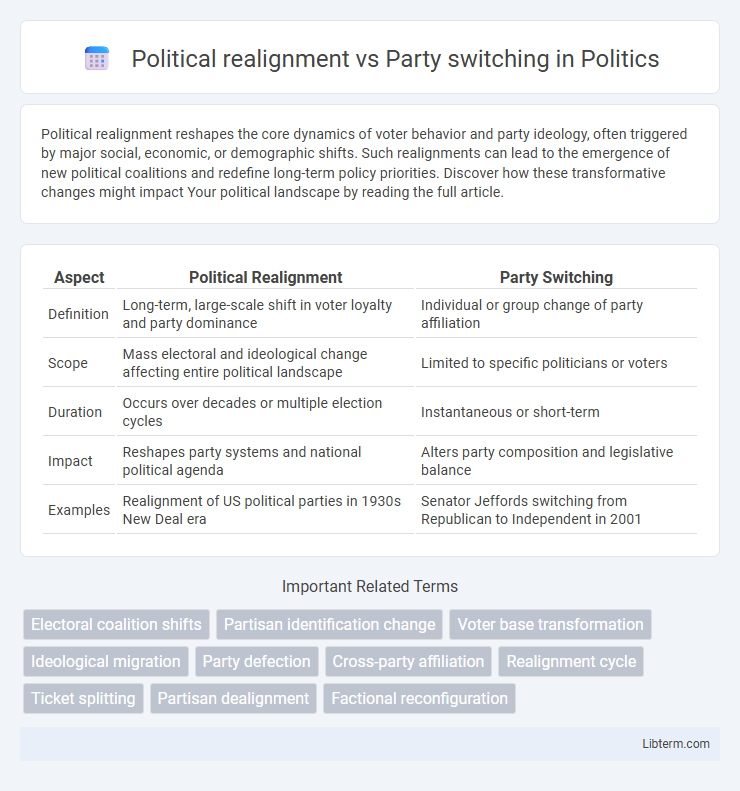Political realignment reshapes the core dynamics of voter behavior and party ideology, often triggered by major social, economic, or demographic shifts. Such realignments can lead to the emergence of new political coalitions and redefine long-term policy priorities. Discover how these transformative changes might impact Your political landscape by reading the full article.
Table of Comparison
| Aspect | Political Realignment | Party Switching |
|---|---|---|
| Definition | Long-term, large-scale shift in voter loyalty and party dominance | Individual or group change of party affiliation |
| Scope | Mass electoral and ideological change affecting entire political landscape | Limited to specific politicians or voters |
| Duration | Occurs over decades or multiple election cycles | Instantaneous or short-term |
| Impact | Reshapes party systems and national political agenda | Alters party composition and legislative balance |
| Examples | Realignment of US political parties in 1930s New Deal era | Senator Jeffords switching from Republican to Independent in 2001 |
Understanding Political Realignment: Definition and History
Political realignment refers to a significant and lasting shift in the political landscape, where large groups of voters change their party allegiance, often resulting in new dominant coalitions. It differs from party switching, which is the individual act of changing party affiliation without necessarily signaling a broader systemic change. Historically, political realignments in the United States--such as those during the New Deal era or the Civil Rights Movement--have reshaped party ideologies and voter bases, reflecting deep transformations in political, social, and economic priorities.
Party Switching: What It Means and Why It Happens
Party switching refers to an elected official's decision to change their political party affiliation, often motivated by ideological shifts, strategic advantages, or changing constituent demographics. This phenomenon can significantly impact legislative dynamics, party balance, and voter trust, highlighting complex interactions between personal beliefs and political strategy. Understanding party switching requires analyzing factors such as policy disagreements, electoral incentives, and evolving political landscapes influencing representatives' alignment choices.
Key Differences Between Political Realignment and Party Switching
Political realignment refers to a long-term, widespread shift in the political landscape, where large groups of voters change their party loyalty, often triggered by critical elections or major social changes. Party switching involves individual politicians or voters changing their party affiliation, reflecting personal or strategic decisions rather than a broad, systemic transformation. The key difference lies in scale and impact: political realignment reshapes party coalitions and national politics over decades, while party switching is typically an isolated, short-term phenomenon.
Historical Examples of Political Realignment in the U.S.
Political realignment in the U.S. refers to significant and lasting shifts in the political landscape, often marked by changes in voter coalitions and party dominance, as seen during the New Deal era when African Americans and labor unions shifted allegiances to the Democratic Party. Party switching involves individual politicians changing their party affiliation, exemplified by Senator Strom Thurmond's switch from Democrat to Republican in 1964 amid Civil Rights debates. Historical political realignments, such as the post-Civil War Republican ascendancy and the Reagan Revolution of the 1980s, reflect broader ideological transformations rather than isolated changes in party membership.
Notable Cases of Party Switching Among Politicians
Notable cases of party switching among politicians often reflect shifts in ideological alignment or strategic electoral considerations, such as Senator Joe Manchin moving from the Democratic to the Republican Party early in his career before returning to the Democrats. Another significant example includes Senator Arlen Specter, who switched from Republican to Democrat in 2009, impacting Senate dynamics during President Obama's administration. These instances highlight individual decisions that differ from broader political realignment trends, which involve mass voter shifts and long-term party system changes.
Causes and Triggers for Political Realignment
Political realignment occurs due to major shifts in voter coalitions triggered by critical events such as economic crises, social movements, or changes in demographic patterns, reshaping long-term party dominance. Party switching involves individual politicians changing affiliation for strategic advantages or ideological realignment, but does not necessarily signal a systemic shift. Causes of political realignment often include transformative elections, pivotal policy debates, or significant population changes that alter the political landscape on a broad scale.
Motivations Behind Party Switching: Ideology, Strategy, or Survival?
Party switching often reflects shifts in personal ideology, strategic calculations to gain political advantage, or efforts to ensure political survival amid changing electoral landscapes. Political realignment, by contrast, denotes broader, systemic transformations in voter coalitions and party dominance, reshaping the political order over time. Understanding the motivations behind party switching requires analyzing individual incentives against the backdrop of evolving party platforms and voter bases.
Political Realignment’s Impact on Voters and Election Outcomes
Political realignment significantly reshapes voter behavior by altering party coalitions and redefining core issues, leading to shifts in electoral demographics and long-term dominance of emerging political factions. This phenomenon often results in pivotal election outcomes, as new voter alignments create electoral advantages that realign power structures at local, state, and national levels. The lasting impact on election results is evident in transformed party platforms and sustained changes in voter loyalty patterns across multiple election cycles.
Consequences of Party Switching for Political Parties and Legislatures
Party switching often results in shifts in legislative majorities, affecting party cohesion and policy agendas within political parties. Legislatures may experience instability and altered power dynamics, as defections can prompt realignments of committee memberships and leadership roles. This phenomenon challenges party discipline and complicates coalition-building processes, impacting governance effectiveness.
The Future of Political Realignment and Party Switching in Modern Politics
Political realignment redefines voter coalitions and ideological bases across multiple election cycles, while party switching involves individual politicians changing affiliation to align with shifting political landscapes. The future of political realignment suggests increasing fragmentation driven by identity politics and issue-based voting, whereas party switching may intensify as electoral volatility and polarized electorates pressure politicians to adapt. Modern politics expects digital media's influence to accelerate these trends, reshaping party systems and voter engagement dynamically.
Political realignment Infographic

 libterm.com
libterm.com